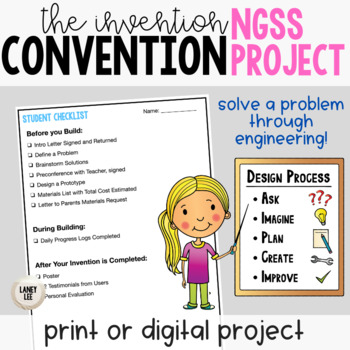Invention Convention - Student Led STEM Project
- PDF
- Google Apps™

What educators are saying
Also included in
- Is lesson planning just too much on top of teaching on top of grading on top of classroom management on top of *ahem* living your life? Get all the guidance you need to teach a comprehensive, no-prep engineering unit either in person, hybrid, or virtual with my all inclusive unit bundle! This unitPrice $21.00Original Price $30.00Save $9.00
Description
Looking for a fun way to wrap up your engineering unit? This project brings inventions to life and captures imaginations as students answer the question: What does it take to invent something new?
Your students will be guided through the engineering design process of designing as they solve a problem with technology! This project guides students through the following steps in a 16 page booklet:
- To Do Checklist
- Define a Problem
- Brainstorming Solutions
- Pre Conference Form with Teacher
- Develop a Model
- Materials List
- Materials Request Letter
- Daily Progress Logs
- Create a Poster
- 2 User Testimonials
- Self Evaluation
- Formative Rubric
- Summative Rubric
Who is this resource for?
This resource can be used by classroom teachers, tutors, and parents of students in grades 6-9.
How Can I Use this Resource?
- Formative or Summative Assessment
- Inquiry based instruction
- Creation of Independent Work Packet for students who are not able to be present for direct instruction.
- Extension activity for early finishers or for students who show a special interest in the topic
What's Included?
Summative & Formative Rubrics
7 Mini Lessons Covering:
- Day 1: Project Overview
- Day 2: Technology and Engineers
- Day 3: Obsolete Technologies
- Day 4: Steps of the Engineering Design Process
- Day 5: Intended Benefits and Unintended Consequences
- Day 6: Engineering and Society
- Day 7: Preparing for the Invention Convention
Parent Letter
Print & Digital Student Booklet
Purchase includes a printable PDF file in color. On page 2 of this resource you will find a link to a student friendly Google Slide version of this file. You will be able to copy this file and use it with Google Classroom or any other paperless initiative.
Please take a look at the preview file & video to see more of this resource.
More questions?
Email me at laneyleeteaches@gmail.com
-------------------------------------------------------------------------------------------------------------------------------
Read this blog post to see more examples of student work!
-------------------------------------------------------------------------------------------------------------------------------
More on engineering:
- Engineering Design Process Guided Reading
- Engineering Design Process Presentation
- Intro to Engineering Presentation
- Bioengineering Webquest
- Inventions Webquest
- STEM Tower Challenge
- Bill Nye: Inventions Viewing Guide
- Color by Number
- Invention Convention Project (2 weeks)
- FULL ENGINEERING UNIT (SAVE 30%)
-------------------------------------------------------------------------------------------------------------------------------
To stay updated on sales and new products, please follow my store:
Connect and chat with me!






